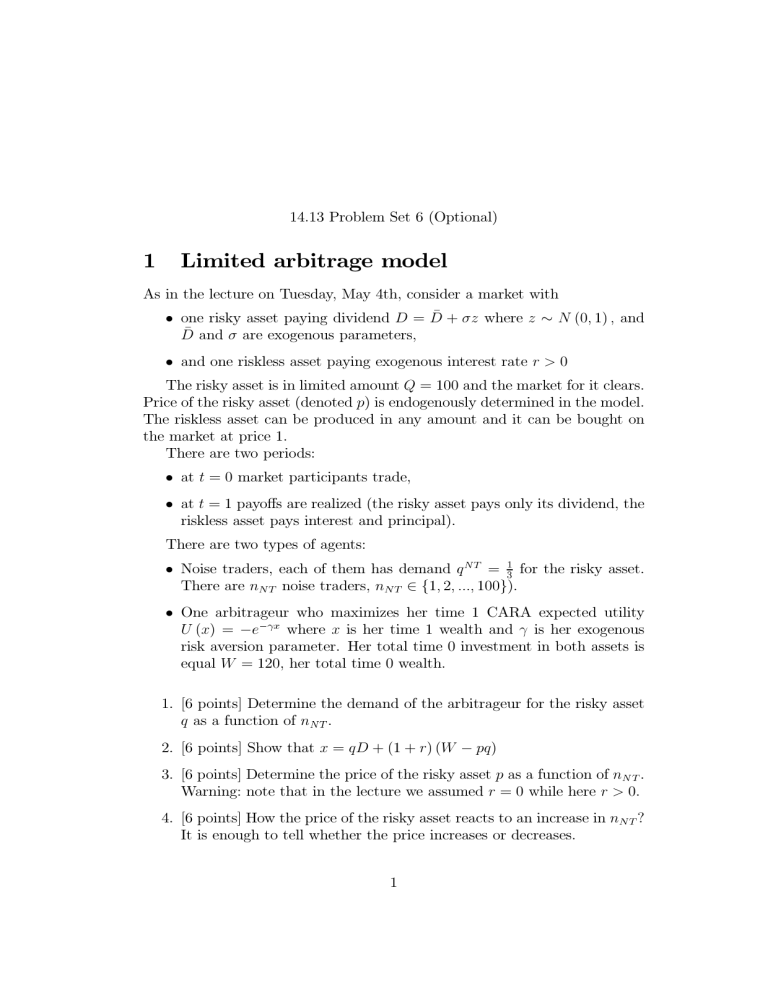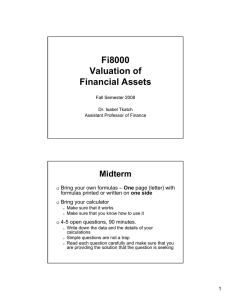1 Limited arbitrage model

14.13 Problem Set 6 (Optional)
1 Limited arbitrage model
As in the lecture on Tuesday, May 4th, consider a market with
• one risky asset paying dividend and σ
D are exogenous parameters,
= ¯ + σz where z ∼ N (0 , 1) , and
• and one riskless asset paying exogenous interest rate r > 0
The risky asset is in limited amount Q = 100 and the market for it clears.
Price of the risky asset (denoted p ) is endogenously determined in the model.
The riskless asset can be produced in any amount and it can be bought on the market at price 1 .
There are two periods:
• at t = 0 market participants trade,
• at t = 1 payoffs are realized (the risky asset pays only its dividend, the riskless asset pays interest and principal).
There are two types of agents:
• Noise traders, each of them has demand q NT
There are n
NT noise traders, n
NT
∈ { 1 , 2 , ...,
=
100 }
1
3
).
for the risky asset.
• One arbitrageur who maximizes her time 1 CARA expected utility
U ( x ) = − e −γx where x is her time 1 wealth and γ is her exogenous risk aversion parameter. Her total time 0 investment in both assets is equal W = 120 , her total time 0 wealth.
1. [6 points] Determine the demand of the arbitrageur for the risky asset q as a function of n
NT
.
2. [6 points] Show that x = qD + (1 + r ) ( W − pq )
3. [6 points] Determine the price of the risky asset p as a function of n
NT
Warning: note that in the lecture we assumed r = 0 while here r > 0 .
.
4. [6 points] How the price of the risky asset reacts to an increase in n
It is enough to tell whether the price increases or decreases.
NT
?
1
2 Twin Stocks
Imagine that the money managers who invest MIT’s endowment have come to you for advice. They tell you about a company, Smith Kline Beecham, which has two classes of stock: E and H. These two classes of stock are identical in terms of their voting rights and their claims on the profits (and potentially liquidation value) of the firm. All payouts (i.e., dividends) are equalized across the types of stock, so that one class E share must provide the same dividend flow as one class H share.
1. [8 points] What does the efficient market theory predict about the relative prices of class H and E shares?
2. [8 points] It turns out that the class H shares have traded at a price higher than the class E shares since the two classes were established.
The money managers wants to know how to expolit this deviation.
Describe an investment that will enable them to arbitrage the price deviation.
3. [8 points] Write a short memo to the managers explaining the pros and cons of this arbitrage. What are the potential payoffs and what are the risks?
2





